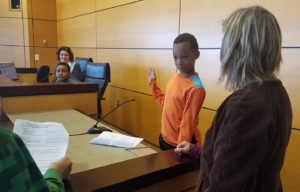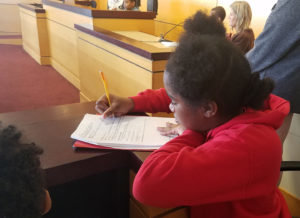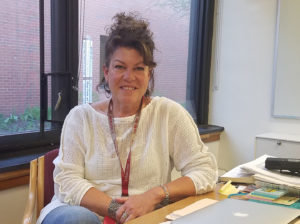 Photo by Jan Willms
Photo by Jan WillmsBy Jan Willms
What is it like to be in a courtroom? Serve as a prosecutor or defense lawyer? Preside as a judge? Be part of a jury?
Fifth graders at Hamline Elementary, 1599 Englewood Ave., were able to walk across the street on April 26, 2019, and find the answers as they participated in a mock trial that took place in the moot courtroom of West Hall at Hamline University.
The learning experience is all part of a collaboration between the elementary school and the university that started 125 years ago. The mock trials have been going on for at least the past 12 years.
“Each grade level has a departmental/academic pairing with the university,” said Kristin Reilly, principal of Hamline Elementary. “As teachers build units around standards, we try to make the connection with the university that is aligned to learning outcomes. Fifth grade is a grade in which social justice issues come up often in the curriculum.
“Having university students and professors work with our teachers and students to enrich and expand learning is a win/win for everyone involved,” continued Reilly.
She said the fifth graders work with Hamline University students and professors to dive into a specific case. The case that was tried in April was the State of Minnesota vs Mike Jacobs. Reilly said Jacobs was being charged with spray painting a racist statement on a locker of another student, Chris Burke. It was damage of property in the third and fourth degree.
“It is up to the students to dig into the case and dependent on their role bring this process to life,” Reilly added.
According to Jodie Wilson, a teacher and alumnae of Hamline elementary who serves as a liaison for the collaboration, university students come over a couple of weeks in advance of the mock trial and help the elementary students prepare.
“This experience allows the students to see themselves in the real world,” Wilson said. “They can see how school is like real life, with rules and consequences.”
 Reilly explained that the roles students play in the trial process are determined by the interest level of the students. “Depending on their comfort level, the students decide what role they will take, but the expectation is that everyone participates. What is always wonderful to see is that students who may struggle in other areas of learning can really shine when learning is authentic and builds upon strengths.”
Reilly explained that the roles students play in the trial process are determined by the interest level of the students. “Depending on their comfort level, the students decide what role they will take, but the expectation is that everyone participates. What is always wonderful to see is that students who may struggle in other areas of learning can really shine when learning is authentic and builds upon strengths.”
The fifth grade students themselves were positive about the experience. One student who played the role of a prosecutor said he was excited about it and practiced a lot. “It is possibly something I could do,” he said. Another student who played a police officer giving testimony said, “It’s fun, because you can say whether they are guilty or not guilty. You can learn more if you want to be a lawyer when you grow up.”
Reilly said that when students see themselves as part of a larger part of society, the impact is immense. “The opportunity for our fifth graders not only to understand how our legal system works, but also to have a real life experience and take an active role builds thinking skills, develops speaking and presentation skills, and taps into who they are and what they believe.”
Stacy Agha, a parent in attendance at the mock trial, said her son had told her he was a witness but had not said much more about it, so she came to observe. “He has a Hamline University buddy, so he comes over here a lot. He tells me this is where he is going to college,” she said.
Scholarships are available at Hamline University for Hamline elementary students when they are ready to enter college.
The mock trial experience is only one of four programs that are a part of the pairing of the schools, according to Kevin Yang, coordinator of civic engagement for the Hamline to Hamline Collaboration. “We also have the tutoring program, where university students get paid work-study to work directly with the elementary teachers,” he said. “Another is called Hand in Hand, which is a program where university students called buddies get to volunteer with elementary buddies for 45 minutes a week, reading together and getting a chance to build an authentic relationship.”
Yang said there is also a project called Snelling Connection, which is a newspaper operated by fourth and fifth graders, with two editors and teachers from Hamline University. “They develop reading and writing skills, and confidence,” he said. He added that the mock trial, which is part of an academic program shared between the two schools, is a powerful learning experience for students from Hamline University and Hamline Elementary.
Reilly concurred. “Currently this valuable and cherished partnership, the Hamline to Hamline Collaboration, includes over 70 classroom tutors per week, academic and activity pairings at all grade levels, classes, gifted and talented programming and many other meaningful connections,” she said. “This collaborative learning community brings one of a kind opportunities for elementary students, college students, teachers and professors that enriches learning through shared campuses, resources and experiences. We are two campuses but one community in the heart of the neighborhood.”
Comments
No comments on this item Please log in to comment by clicking here